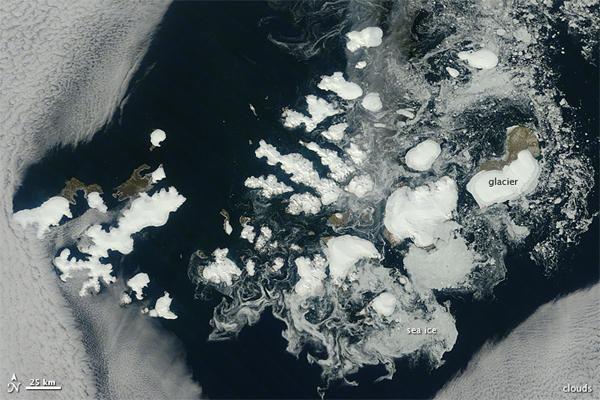
Icy Islands: Russia's Northernmost Territory

Russia's northernmost territory, Franz Josef Land, is an archipelago of 191 islands in the northeastern Barents Sea. On August 17, 2011, clear skies allowed the Moderate Resolution Imaging Spectroradiometer (MODIS) on NASA's Terra satellite this unobstructed view.
Clouds fringe this natural-color scene, like curtains held back from a window. Around the islands, sea ice forms serpentine shapes of light gray and dull white. The glaciers that cap many of the islands are bright white. In ice-free areas, land cover is pale brown, typical of tundra.
Situated about 1,000 kilometers (625 miles) from the North Pole, Franz Josef Land has a punishing climate. The average summertime temperature is just 35 degrees Fahrenheit (2 degrees Celsius), and the average wintertime temperature is -8 degrees Fahrenheit (-22 degrees Celsius). Vegetation includes lichens, mosses, and Arctic flowering plants.
The archipelago is comprised of marine deposits built into low-lying islands. Although some studies have dated the rocks to the Mesozoic Era (the Age of Reptiles), fossils in coal deposits from the eastern reaches of Franz Josef Land suggest that the rocks might be even older.
Geologic processes of uplift and erosion have shaped Franz Josef Land since the time of the dinosaurs. During the Jurassic Period about 206 to 144 million years ago, the islands experienced uplift, and may have been a single landmass. Soon after the area was uplifted, it began to erode. But the erosion was unevenmost intense along the archipelago's eastern and western margins, and less intense in the center.
During the Cretaceous Period about 144 to 65 million years ago, large-scale seismic activity coated parts of Franz Josef Land with volcanic rock. In more recent times, ice has shaped the archipelago. Beginning about 1.8 million years ago, massive ice sheets advanced and retreated over the Northern Hemisphere, grinding and shaping the land surface. Although ice sheets have retreated, glaciers have remained, coating much of this archipelago in icy white.
- Nature to the Rescue: Barriers to Storm Surge
- Astronauts Catch Glimpse of 'Sunglint' Off Massachusetts Coast
- 7 Most Dangerous Places on Earth
Sign up for the Live Science daily newsletter now
Get the world’s most fascinating discoveries delivered straight to your inbox.











